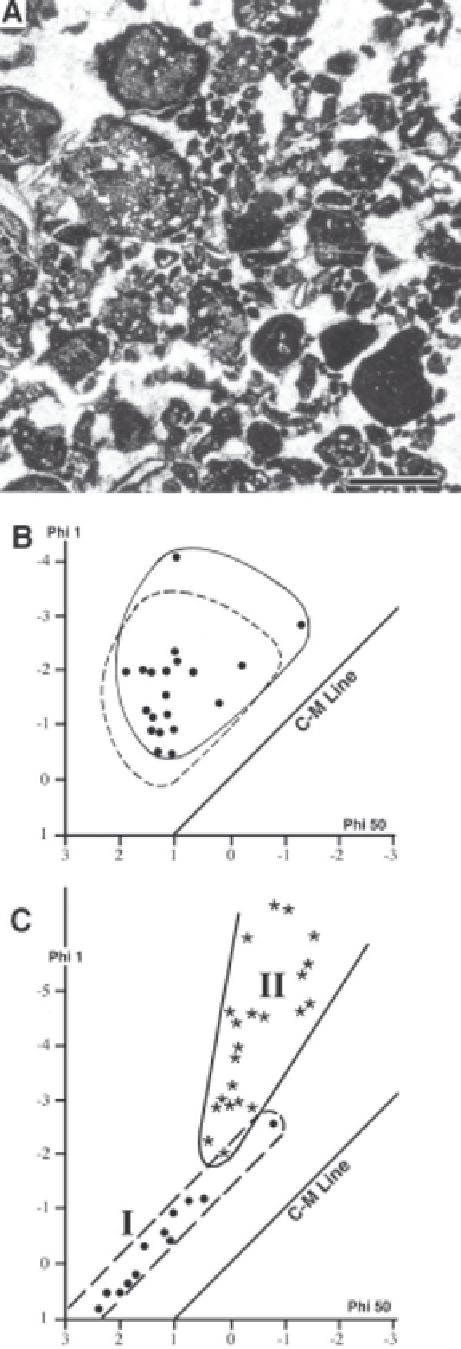Geology Reference
In-Depth Information
Fig. 6.6.
Passega diagram of Late Jurassic limestones from
the Alps.
The one percentile (φ 1, C) measures the coarsest
grain in the deposit; the median (φ 50, M) measures the total
population and considers the fine grains in the tail of the dis-
tribution.
A
and
B
- Sulzfluh limestone.
A
: Moderately sorted, coarse-
to medium-grained calcarenite consisting of large and small
lithoclasts. Note that some lithoclasts are encrusted and in-
clude microfossils. Scale is 2 mm.
B
: Passega diagram. The field included by the straight line is
the pattern based on number frequencies. The only slightly
divergent shape of the other field (sample points not shown)
results from the conversion of thin-section measurements into
weight percentages after Friedman (1958). The C-M pattern
is considered to be characteristic for beach sediments. Modi-
fied after Ott (1969).
C
: C-M diagrams for Barmstein limestone (I) and the Tressen-
stein limestone (II). Pattern I is regarded as being character-
istic for deposition from turbidity currents, pattern II has been
interpreted as a possible coastal deposit affected by tractive
currents. Tractive currents are caused by waves and currents
touching the bottom. Modified from Hötzl (1966).
sition of most Barmstein beds as turbidites (Steiger
1981). This interpretation is supported by the C-M pat-
tern shown in Fig. 6.6C). The C-M pattern of the
Tressenstein limestone indicates the transport of coastal
material and the deposition by tractive currents. This
picture would fit into a depositional model considering
the Tressenstein limestone as a sediment deposited on
the gentle foreslope of a platform or on the near-coast
slope of the inner part of a carbonate ramp.
6.1.2.3 Significance of GrainSize Studies of
Carbonate Rocks
Grain-size studies of carbonate rocks are applied to:
• Limestone classification: All textural classifications
and some classifications used in differentiating poros-
ity types and limestone resources need to know the per-
centages of grains of specific grain sizes (Sect. 7.3.2
and 8.1).
• Recognition of depositional processes and hydro-
dynamic conditions (see this section and Sect. 12.1.1).
• Differentiation of reef complexes: Grain-size ranges
and average grain sizes vary in traverses crossing back-
reef, reef and forereef of some modern reef complexes.
Comparable patterns have been observed, e.g. in Tri-
assic and Jurassic platform-margin reefs.
• Information on diagenetic changes: The size of cal-
cite and dolomite crystals in recrystallized carbonate
rocks and the apparent sorting coefficients indicate the
degree of neomorphic alterations (Germann 1963).

